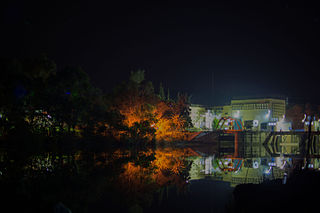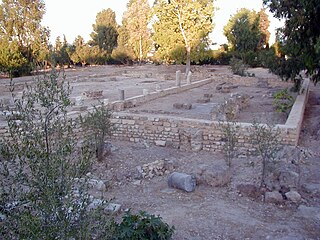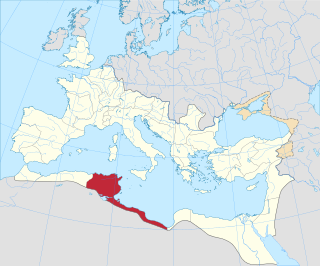| Part of a series on the |
| Catholic Church by country |
|---|
 |
| |

The Catholic Church in Tunisia is part of the worldwide Catholic Church, under the spiritual leadership of the Pope in Rome.
| Part of a series on the |
| Catholic Church by country |
|---|
 |
| |

The Catholic Church in Tunisia is part of the worldwide Catholic Church, under the spiritual leadership of the Pope in Rome.
By the mid of the eleventh century, only five bishoprics remained in all of Africa as mentioned in a letter by pope Leo IX who intervened in a struggle for precedence between the bishop of Gummi-Mahdia, who was favoured by the local rulers, and the bishop of Carthage, the traditional head of the church of Africa. [1] Giles of Assisi and several other Franciscans came to Tunis in 1219 in order to preach to the Muslims, but they were send back by the local Christians in fear of repercussions. [2]
Like the Almohads, the Hafsids maintained Christian mercenaries who lived in a neighbourhood closed of with a gate near the Hafsid palace complex. They worshipped in a church dedicated to Saint Francis of Assisi which visitors described as "very beautiful and great" and which was allowed to ring the bell, a practice forbidden by the so-called Pact of Umar and a privilege not granted to the Genoese and Venetian merchants who maintained chapels in their merchant quarters. When Jean Adorno visited Tunis in 1470, he described these Christians as assimilated culturally and linguistically into Tunisian society, though they remained Christians and would sing in Latin during mass. [3]
From the late 19th century to after World War II, Tunisia was home to large populations of Christian French, Italian and Maltese descent (255,000 Europeans in 1956). [4] The number of Catholics fell following Tunisian independence. The ownership of many Catholic buildings, including the Saint Louis Cathedral, was transferred to the state under a modus vivendi reached between the Holy See and the Republic of Tunisia. [5]
The Catholic church in Tunisia presently comprises only a single Latin archbishopric, in the national capital Tunis :
There are no Eastern Catholic, pre-diocesan or other exempt jurisdictions in Tunisia.
As this solo-episcopate warrants no national conference, it partakes in the regional Episcopal conference of Northern Africa (French: Conférence Episcopale Régionale du Nord de l’Afrique, C.E.R.N.A.) together with Algeria, Morocco (hosting the headquarters in Rabat), Western Sahara and Libya, the 'Great Maghreb' (Arab region West of Egypt).
There is also an Apostolic Nunciature (papal diplomatic representation at embassy-level) to Tunisia, which is however vested in the Apostolic Nunciature to neighbour Algeria (in Algiers).
All defunct jurisdictions are precursors of current (residential or, mostly, titular) sees. [6]
There are around 30,700 Catholics in this predominantly Islamic country, which forms a single diocese – the Archdiocese of Tunis. Accordingly, the only Catholic cathedral is that of St. Vincent de Paul in Tunis. The building was completed in 1897, while Tunisia was a French protectorate. Catholic influence during the colonial period also included extensive missionary work by the French Primate of Africa, Cardinal Lavigerie. The cathedral in his time was the church of Saint Louis in Carthage, was also built in the 19th century, when the archdiocese, under Cardinal Lavigerie, held the primacy of all Roman Africa.
In 2022, Catholics formed the majority (around 24,000 out of 30,000) of Christians in the country. [7] In the past, the Diocese of Tunis operates 12 churches, 9 schools, several libraries, and 2 clinics as well as holding religious services, running a monastery, freely organized cultural activities, and performed charitable work throughout the country. [8] Occasionally, Catholic religious groups held services in private residences or other locations. [8]
Pope John Paul II visited Tunisia on April 15, 1996, to give support to the Church there and called for a peaceful dialogue between Muslims and Christians across North Africa. [9] [10]
In 2023, the country was scored 3 out of 4 for religious freedom. [11] In the same year, it was ranked as the 36th worst place in the world to be a Christian. [12]

Byzacena was a Late Roman province in the central part of Roman North Africa, which is now roughly Tunisia, split off from Africa Proconsularis.

Charles Martial Allemand Lavigerie, M. Afr. was a French Catholic cardinal, Archbishop of Carthage and Algiers and Primate of Africa. He also founded the White Fathers.

The Archdiocese of Tunis is a Latin Church ecclesiastical territory or diocese of the Catholic Church in Tunis, Tunisia. It was founded on 10 November 1884 under the name "Archdiocese of Carthage", with territory corresponding to that of the then French protectorate of Tunisia. On 9 July 1964, it became a territorial prelature under the ecclesiastical title of Prelature of Tunis. It was made a diocese, keeping the name of Tunis, on 31 May 1995, and raised to the rank of archdiocese on 22 May 2010.

The Cathedral of St. Vincent de Paul is a Roman Catholic church located in Tunis, Tunisia. The cathedral is dedicated to Saint Vincent de Paul, patron saint of charity. It is the episcopal see of the Archdiocese of Tunis and is situated at Place de l'Indépendence in Ville Nouvelle, a crossroads between Avenue Habib Bourguiba and Avenue de France, opposite the French embassy.

The name early African church is given to the Christian communities inhabiting the region known politically as Roman Africa, and comprised geographically somewhat around the area of the Roman Diocese of Africa, namely: the Mediterranean littoral between Cyrenaica on the east and the river Ampsaga on the west; that part of it that faces the Atlantic Ocean being called Mauretania, in addition to Byzacena. Thus corresponding somewhat to contemporary Morocco, Algeria, Tunisia and Libya. The evangelization of Africa followed much the same lines as those traced by Roman civilization. From the late fifth and early sixth century, the region included several Christian Berber kingdoms.

The Acropolium, also known as Saint Louis Cathedral, is a former Roman Catholic church located in Carthage, Tunisia.

Tebourba is a town in Tunisia, located about 20 miles (30 km) from the capital Tunis, former ancient city and bishopric, now a Latin Catholic titular see.
The Primate of Africa is an honorific title in the Roman Catholic church, but in early Christianity was the leading bishop (primas) in Africa except for Mauretania which was under the bishop of Rome and Egypt which was suffragan to Alexandria.
Sufes was a town in the late Roman province of Byzacena, which became a Christian bishopric that is included in the Catholic Church's list of titular sees.

The Archdiocese of Carthage, also known as the Church of Carthage, was a Latin Catholic diocese established in Carthage, Roman Empire, in the 2nd century. Agrippin was the first named bishop, around 230 AD. The temporal importance of the city of Carthage in the Roman Empire had previously been restored by Julius Caesar and Augustus. When Christianity became firmly established around the Roman province of Africa Proconsulare, Carthage became its natural ecclesiastical seat. Carthage subsequently exercised informal primacy as an archdiocese, being the most important center of Christianity in the whole of Roman Africa, corresponding to most of today's Mediterranean coast and inland of Northern Africa. As such, it enjoyed honorary title of patriarch as well as primate of Africa: Pope Leo I confirmed the primacy of the bishop of Carthage in 446: "Indeed, after the Roman Bishop, the leading Bishop and metropolitan for all Africa is the Bishop of Carthage."
Aquae Novae in Proconsulari is a former Ancient city and bishopric in Roman Africa and present Latin Catholic titular see.

Aquae in Proconsulari is a former Ancient city and bishopric in Roman Africa and present Latin Catholic titular see.

Vazari-Didda or Vazari Didda) was an Ancient city and bishopric in Roman Africa, which remains a Latin Catholic titular see.

Abbir Germaniciana also known as Abir Cella is the name of a Roman and Byzantine-era city in the Roman province of Africa proconsularis. The city was also the seat of a bishopric, in the ecclesiastical province of Carthage, and is best known as the home town of the Pre Nicaean father, Cyprian, who was bishop of Abbir Germaniciana around 250AD.
Bir Mcherga is a town and commune in the Zaghouan Governorate, Tunisia in the northwest of Tunisia, the site of former Roman North African city and bishopric Giufi, which only remains as Latin Catholic titular see.

Gummi in Byzacena was a city and bishopric in Roman Africa, which remains a Latin Catholic titular see.

Feradi Minor was an ancient town in the Roman province of Africa proconsularis in the Sahel region of Tunisia. During late antiquity it was in the province of Byzacena.

Muzuca was a Roman Town of the Roman province of Byzacena during late antiquity. The town has tentatively been identified with the ruins at Henchir-Besra in modern Tunisia. Very little is known of the city, though in situ epigraphical evidence gives us the name and that in late antiquity it achieved the status of Municipium.

Marazanae was a Roman town of the Roman province of Byzacena during the Roman Empire and into late antiquity.